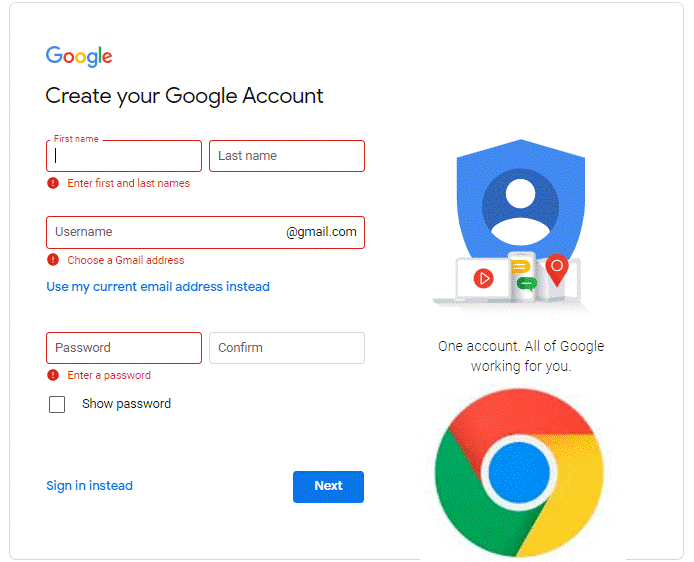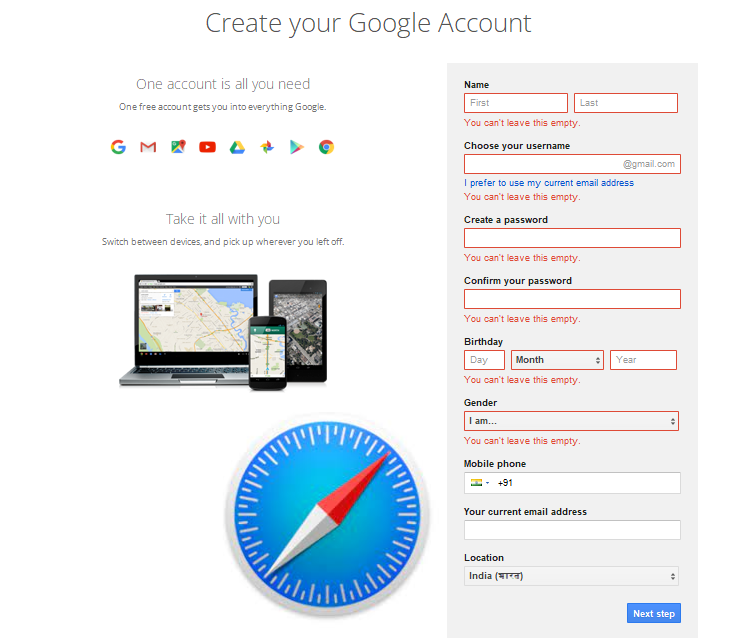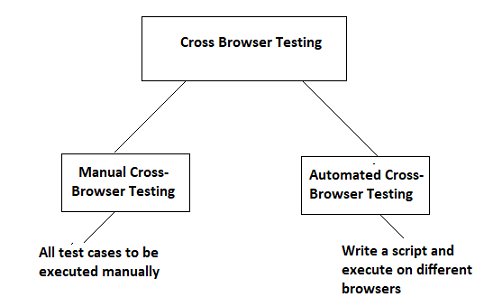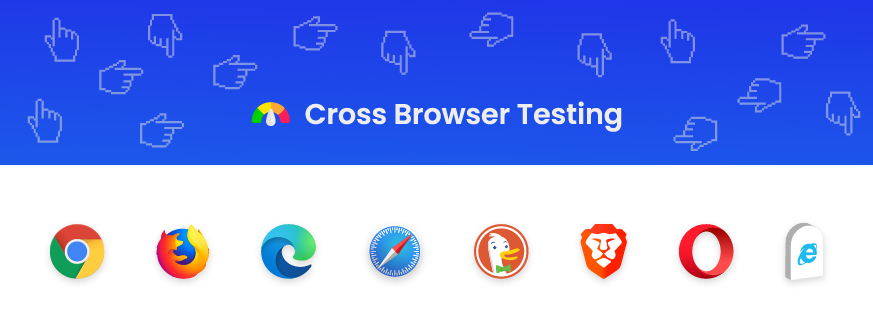what is cross browser testing and why is it important? “Cross Browser testing means how the application works in different browsers, whether a mobile browser, desktop, or tablet.”
The web application operates differently in CSS, Javascript, AJAX, and Flash browsers. So cross-browser testing is done to prevent this issue, and it is a sure-shot practice that one should not ignore before launching a web application.
Why Do We Need Cross Browser Testing?
Here is the reason why cross browser testing is important: The web application can be opened in any browser by end-user
For Example, you might prefer a chrome browser to open a google signup page, whereas others might be using Firefox or Safari.
In the below image, you can observe that signup forms are not the same in both the browsers, and if you look at the design layout, font, validation message, it will also be different.


So here I am pretty sure that the web application works exactly as the user expects in all the browsers.
Causes of cross-browser issue:
- Html/CSS validation issue
- Lack of testing on real devices
- Doctype error
- Layout compatibility
- JavaScript issues
- Some browsers still do not support html5
- Font size mismatch in different browsers
- Page alignment and div size
Who Conducts Cross browser Testing?
- Anyone who has created or designed a web application can test the application.
- The software testing team is primarily responsible for cross-browser testing.
- The QA team takes care of cross-browser testing to ensure a hassle-free experience and ensure the consistency of functionality.
- When it comes to cross-browser testing, the QA team plays a key role. This is the last line of defense before the website goes live.
How to Perform Cross Browser Testing?
To do CBT, we first need to understand that creating a website that supports all browsers is difficult. There are many browsers on the market today that all work differently. To create something that is not a problem in any browser, you need to invest a lot of time in it. You just have to be more discriminating with the help you render toward other people. This, of course, comes at a cost.
Therefore, to avoid this, we first analyze the customers and try to capture the maximum number of people according to our needs. There are chances that 70% on Google Chrome and 15% on Mozilla Firefox and Microsoft Edge.
We will not spend much time on other browsers. This depends on your project, your needs, and the audience you are targeting. Once you’ve decided that, you have two options:
- Manual cross-browser testing
- Automated cross-browser testing

Manual Cross Browser Testing
- We will install different browsers and operating systems to test the website manually to test on different systems and mobiles. Then we will run all the test cases manually in the prescribed environment. This is a time-consuming and not-so-exciting activity for testers.
- Because of this, the overall testing time is also longer than usual. Also, Manual testing in all environments is practically not an option. Therefore, automation of cross-browser testing is required to complete test activities quickly.
Automated Cross-Browser Testing
- Manual cross-browser testing is impossible with multiple browsers, OS, and devices in today’s scenario. It is practically impossible to cross browser testing manually in many browsers.
- Therefore, automating cross-browser testing is required for organizations running their application across all devices and systems.
- Cross-browser testing can be completed in less time using these automation tools.
- Cross-browser testing will be automated using the following tools:
BrowserStack: BrowserStack is a cross browser testing cloud tool. Developers check their application with different browsers in different operating systems and mobile without installing virtual machines or in emulators.
LambdaTest: LambdaTest is a cross cloud browser testing tool that you performed cross-browser testing for web applications on over 2000 browsers, operating systems, and devices. You can do manual and automated cross-browser testing using the LambdaTest tool
SmartBear: CrossBrowserTesting allows you to perfect every web experience on any browser or mobile device with their cloud-based real device lab.
HeadSpin: Headspin allows users to run cross-browser tests remotely on thousands of real devices in the cloud. Users can easily test their (app cross browser testing) mobile app or website’s responsiveness and perform performance-critical tests like load testing in a real environment for 100% accurate results.
Cross-Browser Testing Advantage:
- Save set up & maintenance costs
- Provide a reliable & stable environment
- Support visual testing, functional testing, regression testing, etc
- Perfect for remote team collaboration & support
- Faster delivery of the final product
- Promotes parallel and 24*7 test execution
- Inexpensive as compared to an in-house setup
Cross-Browser Testing Disadvantage :
- Sometimes, resources can be unavailable due to resource sharing on the cloud.
- Dependent on availability of internet.
- Dependency on the cloud service provider for the quality of services.
- Migration could be an issue.
- Security and privacy issues can arise.
Cross browser Testing Checklist:
- Before starting cross-browser testing, we’d like to make sure the following conditions are met:
- Define the scope of testing– How much testing will be carried out, the deadline for testing, how much functionality will be covered?
- Build a cross-browser testing strategy- Which browsers will be used, which OS and devices will be used.
- Choose the right tool: Select the full automation cross-browser testing tool from the available.
- Validate CSS, HTML and XHTML.
- Alignment and spacing of web elements (text fields, radio buttons, dropdowns, checkboxes, etc.).
- Verify page layout in devices with different resolutions.
- Proper navigation of pages.
- URL links are redirected correctly.
- Forms are working fine- Submit, Cancel, Import, Export, Save, etc.
- Verify Session and Cookies prompt is displayed.
- Verify zoom in and zoom out functionality.
- Verify that pop-ups are working consistently.
Conclusion
- Cross-browser testing reduces errors in the application, and we can fix bugs.
- We know which applications work in which environments, browsers, and devices using cross-browser testing tools.
- Manual cross-browser testing takes more time and more resources and is also more expensive when it comes to manual cross-browser testing. To do this, use the automated cross-browser tool and see if the application works properly in the desired browser.
- Cross-browser testing is one of the important types that increase the application’s quality. We can show the customer that this application works properly in all environments, devices, and browsers, which gives us customer satisfaction.
If you need assistance protecting your existing or upcoming product from terrifying possibilities, connect with us today to leverage our security testing services to safeguard your application by identifying potential vulnerabilities.
Author – Bharat Sathvara (Jr. QA Engineer)















Get in Touch